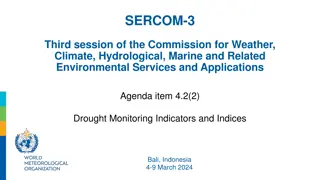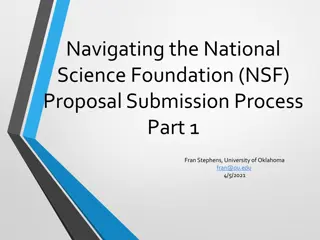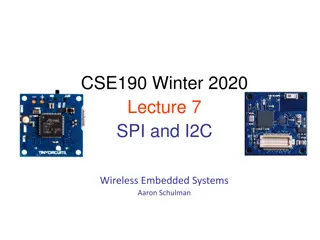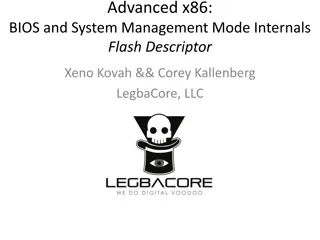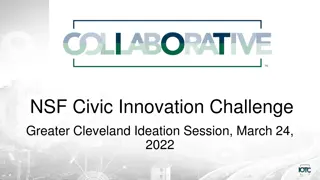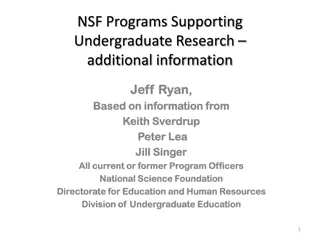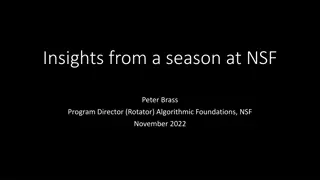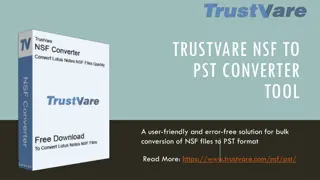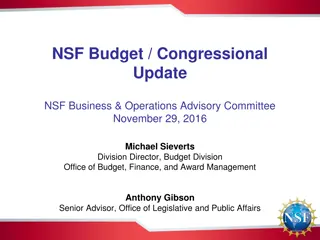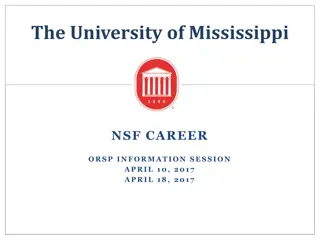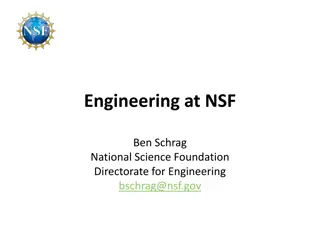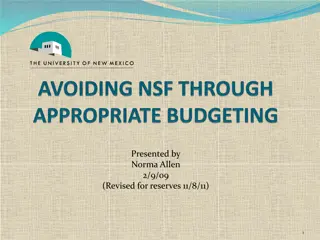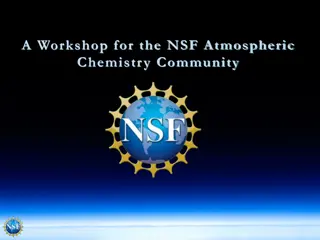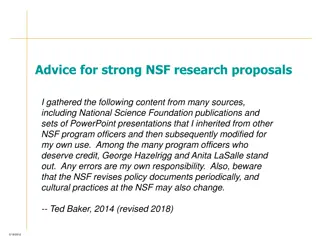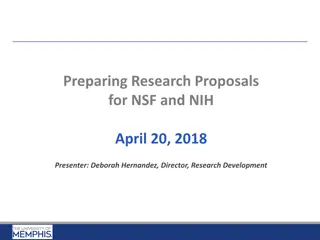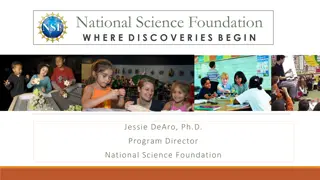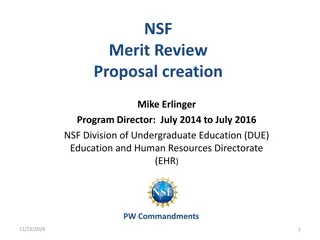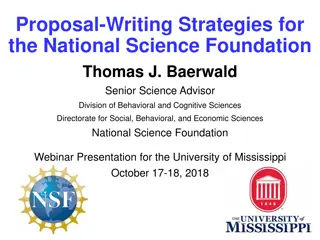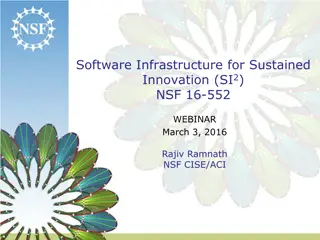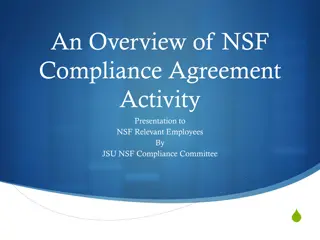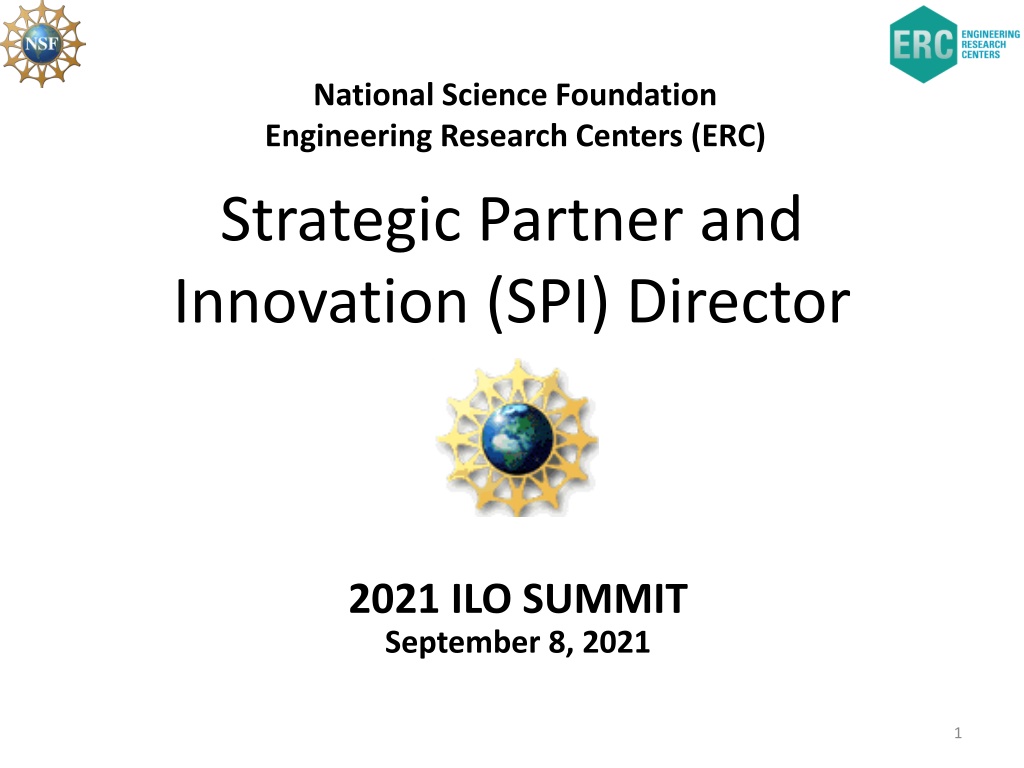
Advancing Engineering Research Centers: Innovations & Changes
Explore the differences between Gen-4 and Gen-3 engineering research centers, understand the functions within the innovation ecosystem, and learn how stakeholders are identified. Discover the evolving landscape of ERC solicitation and the flexibility in eligibility criteria and personnel requirements for principal investigators. Stay updated on the latest developments shaping the future of engineering research.
Download Presentation

Please find below an Image/Link to download the presentation.
The content on the website is provided AS IS for your information and personal use only. It may not be sold, licensed, or shared on other websites without obtaining consent from the author. Download presentation by click this link. If you encounter any issues during the download, it is possible that the publisher has removed the file from their server.
E N D
Presentation Transcript
National Science Foundation Engineering Research Centers (ERC) Strategic Partner and Innovation (SPI) Director 2021 ILO SUMMIT September 8, 2021 1
OUTLINE How does Gen-4 differ from Gen-3? What functions are managed in the Innovation Ecosystem? Industry Management Innovation Management Stakeholder Management How does one know all possible stakeholders have been identified? 2
OUTLINE How does Gen-4 differ from Gen-3? What functions are managed in the Innovation Ecosystem? Industry Management Innovation Management Stakeholder Management How does one know all possible stakeholders have been identified? 3
How Does Gen-4 differ from Gen-3? This ERC solicitation has been informed by a study from the National Academies of Sciences, Engineering, and Medicine (NASEM). The program continues to focus on advancing an engineered system through inclusive cross- disciplinary and cross-sector partnerships, While placing greater emphasis on research that leads to societal impact through convergent approaches, engaging stakeholder communities, and strengthening team formation.
Changes in ERC Solicitation: Flexibility in Eligibility Limit on Number of Letters of Intent and Preliminary Proposals: Per Institution: None Per PI or Co-PI: None The lead institution must have an Engineering Department/School, offering degrees at the Bachelors, Masters, and PhD level. A letter of support must be received from the Dean of Engineering at that institution. (Taken care of)
Changes in ERC Solicitation: Flexibility in Personnel Principal Investigators: The Lead PI must be a tenured faculty member at the Lead Institution; cannot change. The Lead PI does not have to be from an Engineering Department. The Lead PI and the ERC Director are not required to be the same person, but both must be from the Lead Institution. Non-Lead PIs are the PIs listed on the Cover Sheet after the Lead PI and may be from institutions other than the lead university. Non-Lead PIs do not need to be tenured; may change. Leadership Roles: Opportunity for different models of leadership Exception: ERC Administrative Director role is required.
Changes in Solicitation: Flexibility in Management Management Structure: More freedom and creativity Define the roles of various advisory boards/entities Explain the ERC s processes for Team communication Taking in and responding to advisory feedback
OUTLINE How does Gen-4 differ from Gen-3? What functions are managed in the Innovation Ecosystem? Industry Management Innovation Management Stakeholder Management How does one know all possible stakeholders have been identified? 8
ERCs are Charged with Nurturing the Innovation Ecosystem The Gen 4 Innovation Ecosystem is a community of like-minded stakeholders taking advantage of world-class resources proven to deliver results for individuals, teams and organizations, irrespective of geography, industry or company size. ERC stakeholders are the faculty, students, industry partners, state and local governments, regulatory agencies, anyone impacted by proposed technology, etc. 9
Strategic Partner and Innovation (SPI) Director RESPONSIBILITY: Create the strategic plan for nurturing the ERC s innovation ecosystem. Under that umbrella, the SPI Director defines the organization, reporting structure, and processes needed to complete the following three functions: Generic SPI Org Chart Stakeholder Industry Stakeholder Innovation a) b) Nurture innovation ecosystem c) Engage stakeholders Manage industry partner relations
Expectations: ERC Innovation Ecosystem Form strategic partnerships with core industrial/practitioner stakeholders Speed the translation of research into new processes and products as guided by the logic model Engage all stakeholders Follow best practices to optimize utilization of ERC s knowledge/ technology advances Foster entrepreneurial culture by engage ERC students in all phases of the innovation process 11
ERC Partnerships with Stakeholders Foundation of Innovation Ecosystem Partnership goals: information exchange, technology transfer, and student impact Establish Industry Advisory Board governed by a center-wide Membership Agreement and IP Policy establishes policies, membership fees and benefits, etc. 12
Expectations of SPI Director SPI Director is on the ERC Leadership team; Define for each functional group How often they group meets Do they provide SWOT analysis Provide input to strategic planning and project selection/evaluation Generic SPI Org Chart Stakeholder Industry Stakeholder Innovation 13
Roles and Responsibility for Industry Management Function Set vision and strategic plan for industry Market ERC to industry across the IAB value chain Develops and finalizes cross-university membership agreement and IP policy Finalizes Industry partner membership agreement and seals the deal to collect fees See Chapter 5 of ERC Best practices Manual https://erc-assoc.org/best_practices/best-practices-manual 14
Members in MIRTHEs Industry Value Chain Small/large Companies (R&Ds) National Laboratories early adopters 15 Credit: MIRTHE ERC
Roles and Responsibility for Innovation Function Manages the translational research process Develops partnerships to accelerate innovation with state and local government agencies and VCs Integrates innovation ecosystem program with ERC s education program and strategic vision for diversity and a culture of inclusion See Chapter 5 of ERC Best practices Manual https://erc-assoc.org/best_practices/best-practices-manual 16
Roles and Responsibility for Stakeholder Function Stakeholder engagement can take many forms; Engaging advocacy groups; Forming innovation partnerships Seeking membership partners who facilitate tech diffusion Bringing on individual consultants Creating associate membership category Formalization mechanisms How often do they interact with the ERC Team? What is the nature of the interaction? Do/should they generate a SWOT? Do/should they generate a report? This function is new to the Gen 4 ERC.
Gen-4 ERC Stakeholder Definition (pick one) 1. All entities impacting or being impacted by the ERC s Engineered System? 2. Any entity that has an opinion about how the engineered system should be developed and/or rolled out.
OUTLINE How does Gen-4 differ from Gen-3? What functions are managed in the Innovation Ecosystem? Industry Management Innovation Management Stakeholder Management How does one know all possible stakeholders have been identified? 19
Suggested Process for Identifying Relevant Entities A. What entities impact available funding? Commercial funding Government funding NGOs and charities B. What entities or groups comprise the end-user community ? C. What entities or groups are impacted by the technology? Is it a net positive impact Is it a net negative impact D. What entities provide the governing frameworks that define the interactions among A, B, and C above? Policy Regulatory agencies Laws reflecting social desires Tax incentives Established customs Etc.
Site Visit Risk Management Process RISK MANAGEMENT PROCESS feedback ERC PD INPUT SVT OUTCOMES ERC defined risk management process ERC site visit review process ERC o Tech feasibility o Tech translation potential; o Ethics; o Effectiveness of societal impact, o Responsible innovation; o Adaptive regulation & risk governance; o Sustainable Review Criteria ERC SVT Report Dean s Council 21
National Science Foundation Engineering Research Centers (ERC) NSF UPDATES 22
NSF UPDATES New Consulting Contract with Elysium Holdings Erik Sander Scott Ransom NSF s new TIP Directorate Innovation Ecosystem Funding Options SBIR/STTR GOALI SECO INTERN New I/UCRC Option 23
Biden Budget: New NSF Directorate $10.2 billion for NSF in 2022 (20% increase) New TIP research directorate aims to move research more quickly to marketplace TIP Technology, Innovation, and Partnerships Initial budget $865 Million https://www.science.org/news/2021/05/biden-backs-new-nsf-tech-directorate-senate-balks 24
I/UCRC & INTERN Options NSF IIP Program Directors Prakash Balan pbalan@nsf.gov Crystal Leach crleach@nsf.gov 25
Innovation Ecosystem Funding Sources SBIR/STTR https://seedfund.nsf.gov/ GOALI https://www.nsf.gov/eng/iip/goali.jsp SECO https://www.nsf.gov/pubs/2015/nsf15043/nsf 15043.jsp INTERN https://www.nsf.gov/publications/pub_summ. jsp?ods_key=nsf21013 26

